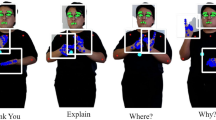Abstract
The recognition of sign language is a challenging task with an important role in society to facilitate the communication of deaf persons. We propose a new approach of Spatial-Temporal Graph Convolutional Network for sign language recognition based on the human skeletal movements. The method uses graphs to capture the dynamics of the signs in two dimensions, spatial and temporal, considering the complex aspects of the language. Additionally, we present a new dataset of human skeletons for sign language based on ASLLVD to contribute to future related studies.
Access this chapter
Tax calculation will be finalised at checkout
Purchases are for personal use only
Similar content being viewed by others
Notes
- 1.
Dactylology - digital or manual alphabet, generally used by the deaf to introduce a word that does not yet have an equivalent sign [11].
- 2.
Available at https://github.com/yysijie/st-gcn.
- 3.
Available at http://csr.bu.edu/asl/asllvd/annotate/index.html.
- 4.
Available at http://www.cin.ufpe.br/~cca5/asllvd-skeleton.
- 5.
Available at http://www.cin.ufpe.br/~cca5/st-gcn-sl.
- 6.
Available at http://www.cin.ufpe.br/~cca5/asllvd-skeleton-20.
References
Athitsos, V., et al.: The American sign language lexicon video dataset. In: 2008 IEEE Computer Society Conference on Computer Vision and Pattern Recognition Workshops, pp. 1–8, June 2008. https://doi.org/10.1109/CVPRW.2008.4563181
Cao, Z., Simon, T., Wei, S.E., Sheikh, Y.: Realtime multi-person 2D pose estimation using part affinity fields. In: CVPR (2017). https://doi.org/10.1109/CVPR.2017.143
Das, A., Gawde, S., Suratwala, K., Kalbande, D.: Sign language recognition using deep learning on custom processed static gesture images. In: 2018 International Conference on Smart City and Emerging Technology (ICSCET), pp. 1–6, January 2018. https://doi.org/10.1109/ICSCET.2018.8537248
ElBadawy, M., Elons, A.S., Shedeed, H.A., Tolba, M.F.: Arabic sign language recognition with 3D convolutional neural networks. In: 2017 Eighth International Conference on Intelligent Computing and Information Systems (ICICIS), pp. 66–71, December 2017. https://doi.org/10.1109/INTELCIS.2017.8260028
Konstantinidis, D., Dimitropoulos, K., Daras, P.: Sign language recognition based on hand and body skeletal data. In: 2018–3DTV-Conference: The True Vision - Capture, Transmission and Display of 3D Video (3DTV-CON), pp. 1–4, June 2018. https://doi.org/10.1109/3DTV.2018.8478467
Laptev, I., Marszalek, M., Schmid, C., Rozenfeld, B.: Learning realistic human actions from movies. In: 2008 IEEE Conference on Computer Vision and Pattern Recognition, pp. 1–8, June 2008. https://doi.org/10.1109/CVPR.2008.4587756
Lim, K.M., Tan, A.W., Tan, S.C.: Block-based histogram of optical flow for isolated sign language recognition. J. Vis. Commun. Image Represent. 40, 538–545 (2016). https://doi.org/10.1016/j.jvcir.2016.07.020
Neidle, C., Thangali, A., Sclaroff, S.: Challenges in development of the American sign language Lexicon video dataset (ASLLVD) corpus. In: 5th Workshop on the Representation and Processing of Sign Languages: Interactions between Corpus and Lexicon, LREC 2012, Istanbul, Turkey, May 2012. https://open.bu.edu/handle/2144/31899
World Health Organization: Deafness and hearing loss, March 2018. https://www.who.int/news-room/fact-sheets/detail/deafness-and-hearing-loss. Online
Pedregosa, F., et al.: Scikit-learn: machine learning in Python. J. Mach. Learn. Res. 12, 2825–2830 (2011). http://www.ee.columbia.edu/~ronw/pubs/jmlr2011-scikit-learn.pdf
Pereira, M.C.d.C., Choi, D., Vieira, M.I., Gaspar, P., Nakasato, R.: Libras - Conhecimento Além Dos Sinais, 1st edn. Pearson, São Paulo (2011)
Peres, S.M., Flores, F.C., Veronez, D., Olguin, C.J.M.: Libras signals recognition: a study with learning vector quantization and bit signature. In: 2006 Ninth Brazilian Symposium on Neural Networks (SBRN 2006), pp. 119–124, October 2006. https://doi.org/10.1109/SBRN.2006.26
Pigou, L., Herreweghe, M.V., Dambre, J.: Gesture and sign language recognition with temporal residual networks. In: 2017 IEEE International Conference on Computer Vision Workshops (ICCVW), pp. 3086–3093, October 2017. https://doi.org/10.1109/ICCVW.2017.365
de Quadros, R.M., Karnopp, L.B.: Língua de sinais brasileira: estudos linguísticos, vol. 1. Artmed, Porto Alegre (2004)
Rao, G.A., Syamala, K., Kishore, P.V.V., Sastry, A.S.C.S.: Deep convolutional neural networks for sign language recognition. In: 2018 Conference on Signal Processing And Communication Engineering Systems (SPACES), pp. 194–197, January 2018. https://doi.org/10.1109/SPACES.2018.8316344
Sajanraj, T.D., Beena, M.: Indian sign language numeral recognition using region of interest convolutional neural network. In: 2018 Second International Conference on Inventive Communication and Computational Technologies (ICICCT), pp. 636–640, April 2018. https://doi.org/10.1109/ICICCT.2018.8473141
Simon, T., Joo, H., Matthews, I.A., Sheikh, Y.: Hand keypoint detection in single images using multiview bootstrapping (2017). http://arxiv.org/abs/1704.07809
Taskiran, M., Killioglu, M., Kahraman, N.: A real-time system for recognition of American sign language by using deep learning. In: 2018 41st International Conference on Telecommunications and Signal Processing (TSP), pp. 1–5 (2018). https://doi.org/10.1109/TSP.2018.8441304
Wei, S., Ramakrishna, V., Kanade, T., Sheikh, Y.: Convolutional pose machines. In: 2016 IEEE Conference on Computer Vision and Pattern Recognition (CVPR), pp. 4724–4732, June 2016. https://doi.org/10.1109/CVPR.2016.511
Yan, S., Xiong, Y., Lin, D.: Spatial temporal graph convolutional networks for skeleton-based action recognition. CoRR abs/1801.07455 (2018). http://arxiv.org/abs/abs/1801.07455
Zheng, L., Liang, B., Jiang, A.: Recent advances of deep learning for sign language recognition. In: 2017 International Conference on Digital Image Computing: Techniques and Applications (DICTA), pp. 1–7, November 2017. https://doi.org/10.1109/DICTA.2017.8227483
Author information
Authors and Affiliations
Corresponding author
Editor information
Editors and Affiliations
Rights and permissions
Copyright information
© 2019 Springer Nature Switzerland AG
About this paper
Cite this paper
de Amorim, C.C., Macêdo, D., Zanchettin, C. (2019). Spatial-Temporal Graph Convolutional Networks for Sign Language Recognition. In: Tetko, I., Kůrková, V., Karpov, P., Theis, F. (eds) Artificial Neural Networks and Machine Learning – ICANN 2019: Workshop and Special Sessions. ICANN 2019. Lecture Notes in Computer Science(), vol 11731. Springer, Cham. https://doi.org/10.1007/978-3-030-30493-5_59
Download citation
DOI: https://doi.org/10.1007/978-3-030-30493-5_59
Published:
Publisher Name: Springer, Cham
Print ISBN: 978-3-030-30492-8
Online ISBN: 978-3-030-30493-5
eBook Packages: Computer ScienceComputer Science (R0)




